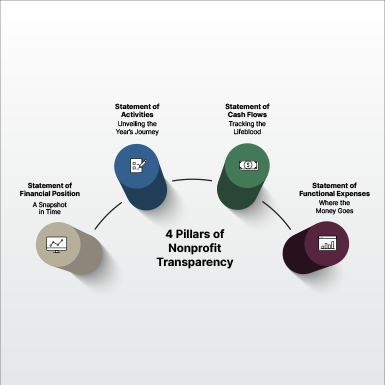4 Pillars of Nonprofit Financial Transparency
Understanding the 4 Pillars of Nonprofit Financial Transparency
Nonprofits, just like for-profit organizations, need to be transparent about their financial health. This transparency allows donors, stakeholders, and the public to make informed decisions and trust the organization’s ability to fulfill its mission. The foundation of this transparency lies in four key financial statements: the Statement of Financial Position, the Statement of Activities, the Statement of Cash Flows, and the Statement of Functional Expenses. While the specific reporting requirements may vary for different types of organizations, understanding these core statements is crucial for anyone engaging with a nonprofit.

1. Statement of Financial Position: A Snapshot in Time
Think of this statement as a financial photograph of the organization at a specific date, typically the end of its fiscal year. It portrays what the organization owns (assets), what it owes (liabilities), and the difference between the two, known as net assets. Assets could include cash, investments, property and equipment, etc., while liabilities represent unpaid bills, loans, and/or grants payable. Essentially, this statement provides a quick glimpse into the organization’s financial stability and resource base.
2. Statement of Activities: Unveiling the Year’s Journey
This statement goes beyond a static picture and tells the story of the organization’s financial performance over the past year. It details all the income earned (revenue) through donations, grants, or program fees, and all the expenses incurred (expenses) in delivering its programs and services. The difference between these two amounts reflects the organization’s net surplus or deficit for the year, indicating whether it generated more resources than it used or vice versa. This statement helps assess the organization’s effectiveness in generating and utilizing resources to achieve its mission.
3. Statement of Cash Flows: Tracking the Lifeblood
While the Statement of Activities focuses on overall financial performance, the Statement of Cash Flows dives deeper into the movement of actual cash. It segregates cash inflows and outflows into three categories: operating activities (day-to-day program expenses), investing activities (purchases or sales of assets), and financing activities (borrowing or repaying of debt). This detailed breakdown is crucial for understanding the organization’s liquidity and its ability to meet short-term financial obligations.
4. Statement of Functional Expenses: Where the Money Goes
This statement delves into the “how” of spending. It categorizes expenses based on the specific functions they support, such as fundraising, program delivery, administration, and governance. This allows for a clearer understanding of how resources are allocated across different areas of the organization and helps assess the efficiency and effectiveness of program delivery.
Building Trust Through Transparency
These four statements, individually and collectively, paint a comprehensive picture of a nonprofit’s financial health, performance, and resource management. By making these statements publicly available and understandable, nonprofits build trust and accountability with their stakeholders. As you interact with a nonprofit, be sure to pay attention to these essential statements to gain a deeper understanding of their financial well-being and ability to deliver on their mission. Remember, informed donors and stakeholders are crucial for the continued success and impact of any nonprofit organization.
Brady Ware Nonprofit Advisors want to help you fulfill your mission with financial health and compliance services and a network of nonprofit consultants who specialize in strategic decision-making.
Questions?
Jacob manages a variety of accounting, audit, review, and compilation engagements for the firm’s Columbus, Ohio, clients in numerous industries, including Nonprofit, Retail, Construction, and Auto Dealers. He has an extensive background in auditing nonprofit organizations, as well as experience in auditing employee benefit plans.